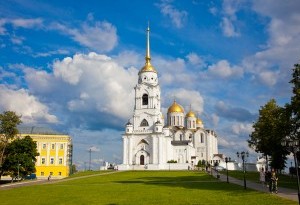Dormition Cathedral, Vladimir

The Dormition Cathedral, which has been standing on the high bank of Klyazma for almost nine hundred years, holds together Russian history, like a huge nail with a golden hat. Without it, it would crumble into separate, unrelated plots and episodes: Kiev princes, Kiev princes, to which the month gallop, Novgorod, which is always in itself and by itself, distant Byzantium with its Orthodoxy and St. Sophia, Moscow, only exalted since 1295 ... The government and the church, princely congresses and internecine fights, important Horde ambassadors and brutal Tatar raids - all this for many centuries was tightly spun around the temple with a golden top, built by masters who came from medieval Europe. It can be seen for tens of kilometers from Vladimir.
The Dormition Cathedral was built in 1158-1160, under Andrei Bogolyubsky, who invited unknown Western European masters to Vladimir. After the fire of 1185, which destroyed all its decoration, except for the miraculous icon of the Virgin, Andrei's younger brother Vsevolod the Big Nest invited a new artel, which erected around the cathedral galleries, four new chapters and new altar apses. After the restructuring, which ended in 1191, the cathedral was able to accommodate 4,000 people and became the largest church of the Russian North-East. With the exception of the western facade, closed by the St. George Chapel and the bell tower of the XIX century, the existing building has retained its pre-Mongol appearance. The historical environment around has also not changed much, and the impression made by the Dormition Cathedral today fully corresponds to its historical significance.
Inside there are small fragments of the 12th century murals - the figures of saints Artemia and Abrahamia, images of lilies and peacocks, as well as the only frescoes that have come down to us, reliably belonging to Andrei Rublev's brush. Rublev, along with Daniel Chorny painted the cathedral commissioned by the Grand Duke. Fragments of the composition “Last Judgment” are extremely interesting, but the unsuccessful restoration of 1960 and the subsequent storage conditions caused irreparable damage to painting. The existing baroque iconostasis was made at the direction of Catherine II.
Princes Andrei Bogolyubsky, Vsevolod the Big Nest, Yury Vsevolodovich, Mikhail Khorobrit, reigning in Moscow in 1247, Metropolitan Maxim, who moved to Vladimir from Kiev in 1299, Vladimir Bishop of Serapion, known for his spiritual writings, are buried in the Dormition Cathedral.
HISTORY
Vladimir was a small fortress in Suzdal, handed over to the son of the founder of Moscow, Yuri Dolgoruky - Andrei. When his father got Kiev, Andrew voluntarily returned to his small town, taking with him the Byzantine icon of the Virgin. He spent all his strength to glorify this city in the center of a vast, but poorly populated forest land. For the icon accompanying him on his way to the north, the prince built a large white-stone cathedral in honor of the Dormition of the Mother of God. An artel, working in the then European Romanesque style, was invited to work, moreover from stone, not from brick, as a master of Greek art from South Russia. The six pillar cathedral with large choirs (a special floor for the prince and his entourage) became the main city temple, intended for the bishop. The bishop's terem was connected with the Dormition Cathedral by a covered passage. Prince Andrew even tried to get the patriarch to create a metropolis in Kiev independent of Kiev, but this did not succeed.
It is believed that Vsevolod, who rebuilt the cathedral, used the services of Russian architects, however, the chronicle quote cited in support of this in fact only says with pride that “not looking for German masters” in 1191 it was possible only to cover the roof of the cathedral with tin Suzdale. In Vladimir in the years 1186-1197, Western Europeans again worked: to take their masters after a twenty-year hiatus in construction was simply nowhere to go.
When in February 1238 Vladimir was taken by the troops of Batu, the townspeople, together with Bishop Mitrofan, locked themselves in the cathedral, but the victors set it on fire. The wife of the Grand Duke Yuri Agafia and her daughter died in the choirs. The decoration of the cathedral was looted, but the Vladimir Icon of the Virgin was preserved.
The Grand Dukes, who owned North-Eastern Russia and Novgorod, came to the throne after a solemn ceremony in the Dormition Cathedral. This tradition was observed until 1432.
In 1395, when Tamerlane marched to Russia from Asia, the Vladimir icon was brought to Moscow. At the meeting place with her was founded Sretensky Monastery. After the conqueror turned back - it was considered a miracle performed by the Virgin Mary - the icon was returned to the Dormition Cathedral. Finally, she returned to Moscow only at the end of the XV century.
Italian architect Aristotle Fioravanti, who was instructed to take Vladimir's cathedral as a model during the construction of the Moscow Dormition Cathedral, came to the city, looked at the temple and praised the work of the ancient builders, proudly noting that this was "our masters' work".
The cathedral bell tower appeared in 1810, and earlier in its place was a travel brick tower with the church of Joachim and Anna, built in 1191. The cathedral, the bishopric and princely courts were at this time surrounded by a wall. Later, a bell-tower hipped was erected on the tower, which was destroyed in 1806 by lightning.
Join our tours and take a look at this amazing attraction:
Excursions - www.uvisitrussia.com/day-tours/tours-to-golden-ring/
Tours - www.uvisitrussia.com/tours-to-golden-ring/



